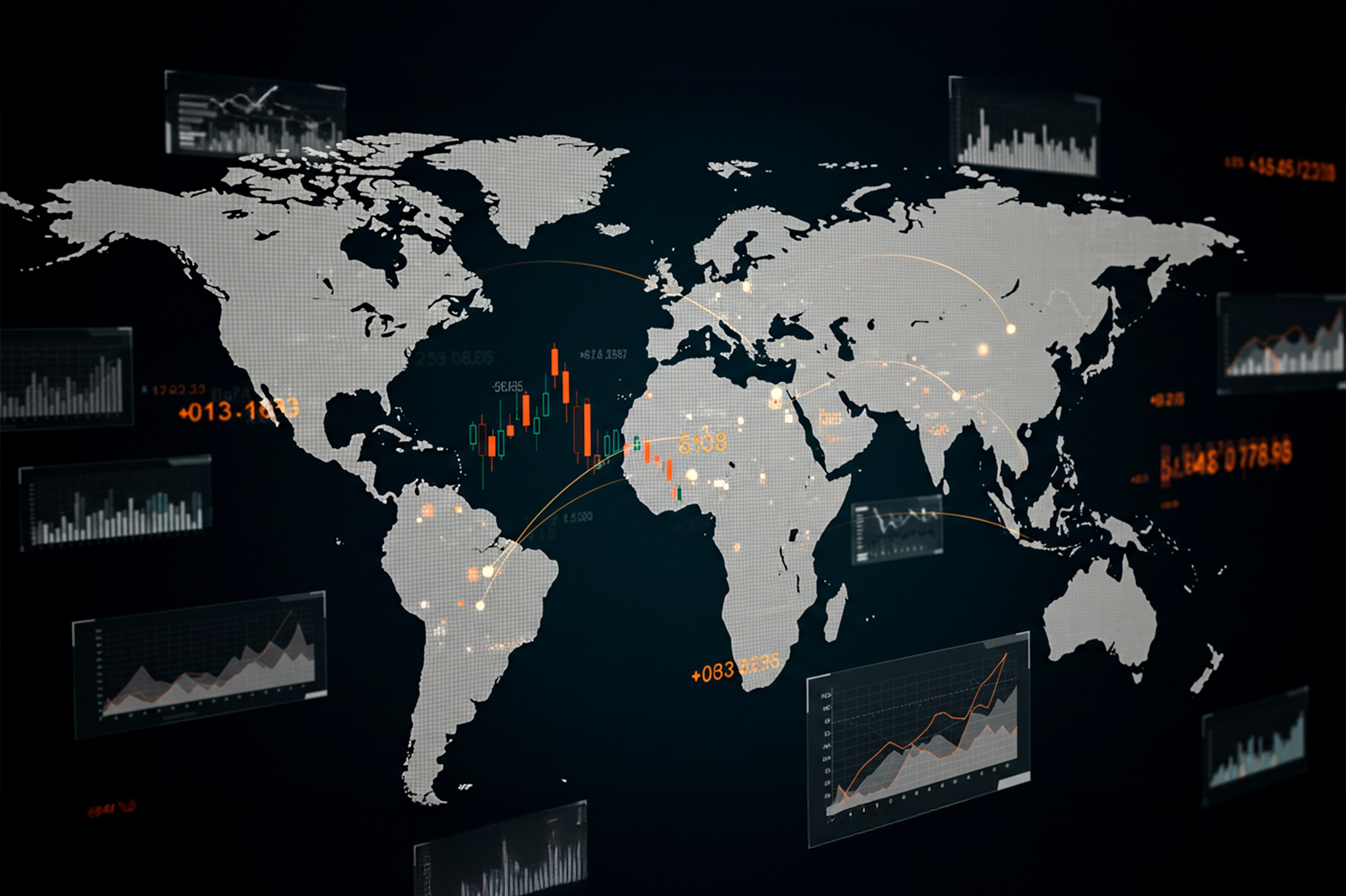Annoucements
Latest videos
Learn More
Understanding Treasury Spreads | EdgeShorts: Futures, Fast & Simple
Trading Strategy vs. Execution | EdgeShorts
What Is Revenge Trading? | EdgeShorts
TradingView Ideas
VIEW ALL posts
MBT1!
, 1W
Bitcoin at the Edge – What Comes Next?
Over the past couple of months, Bitcoin has been navigating a complex mix of macro shifts, liquidity changes, and sector-specific catalysts that, in our opinion, have pushed the market into a critical decision zone. Sentiment has become increasingly divided: long-term structural bulls remain confident, while short- and medium-term flows have turned more cautious.
1. Recent Developments & Market Sentiment
In the past half a year, crypto markets have been influenced by several overlapping narratives. Regulatory tone has eased globally, with more pro-innovation stances emerging in key regions. Political developments—particularly renewed efforts in the U.S. toward clearer crypto frameworks—have added a layer of optimism. Institutional participation has also continued to expand, with ETF flows stabilizing after earlier periods of volatility.
Yet despite these supportive headlines, market behavior has shown hesitation and sold off in the past month. In our opinion, this was driven primarily by the resurfacing of Trump’s aggressive tariff threats, reigniting trade-war fears, a sharp drop in expected Fed rate cuts, and massive institutional ETF outflows plus leveraged liquidations. Sentiment has flipped from extreme greed to extreme fear.
In our view, the inability to sustain acceptance at recent highs points to exhaustion in the prior uptrend. Overall sentiment is less euphoric and more cautious—this current zone would likely be a battleground between long-term accumulation and shorter-term mean reversion.
2. The Underlying Driving Forces
Bitcoin’s medium- and long-term structural drivers remain intact: institutional adoption, the growing integration of digital assets into traditional finance, the post-halving supply dynamics, and Bitcoin’s increasing correlation with broader macro conditions.
Macro factors such as real yields, liquidity conditions, and risk appetite continue to play a major role. As markets position for next year’s rate lowering expectations and potential fiscal shifts, Bitcoin, in our opinion, is behaving more like a liquidity-sensitive asset than a speculative outlier. This is especially apparent in how it has reacted to major economic releases and policy signals. The bottomline is that Bitcoin’s major swings are increasingly tied to macro liquidity flows—the same forces that drive equities, especially high-beta tech.
Market structure is equally important. Bitcoin’s auction process—how price accepts or rejects value—often drives multi-month cycles. When value areas break or hold, the market tends to transition into new regimes. That is exactly where the market appears to be now.
3. Chart Analysis – A True Decision Area
Bitcoin is currently sitting at what we believe is a major inflection point: the 2024 Low-Value Area (LVA), where Bid Block 1 formed in March 2025. This zone acted as the structural base where buyers initiated up to new all-time highs earlier this year.
From July to October 2025, the market attempted to accept near the top of the range, with buyers defending Bid Block 2. By mid-October, however, bid support weakened. Longs unwound, driving price back into Bid Block 1 near 84,600, which is confluent with yearly support and the prior trendline break from November 2024.
Going into the next quarter, Bitcoin sits atop a critical area of demand. In our opinion, how price responds here could determine whether this pullback stabilizes or it becomes a deeper liquidation phase.
Key Levels:
82,000 – 2025 developing low / Bid Block 1 low / 2024 TL breakout
77,000 – 2024 VPOC
Bearish Scenario:
If buyers cannot recover quickly back above 87,700 (2024 VAH), and bids fail to hold the 81,000–77,000 region, the market may open the door to further long liquidation. That could lead to a move through the 2024 Value Area, potentially targeting the 60,000 region (2024 VAL).
Bullish Scenario:
If buyers reject strongly up from the 82,000 area, a move through 94,200 (Bid Block 1 high) could shift control back toward buyers. This may open a path toward 100,000/102,550 (2025 developing VAL / Bid Block 2 low), where sellers could be expected. Acceptance above that could set up a move toward 123,050 (2025 developing VAH) and possibly a revisit of the all-time highs.
Neutral Scenario:
Without any new catalyst, the market may consolidate and form a two-way auction between 99,700 and 82,000 as it digests recent volatility. This could serve as a base for the next directional expansion.
In our view, how Bitcoin behaves around this zone will set the tone heading into 2026. I’d love to hear your views—drop your thoughts in the comments and give this post a boost so others can join the discussion.
This post reflects our personal market views and is for educational discussion only. It should not be interpreted as financial or trading advice. Market conditions can change rapidly, and the levels discussed here may shift as new information emerges. Always conduct your own research and consult a licensed financial professional before making trading decisions.
ES1!
, 1D
From Shutdown Relief to AI Anxiety — Two Narratives Driving ES
Market Theme
The week began on a strong footing, driven by a bullish Sunday reopen in ES after news broke that the 43-day government shutdown was set to end, following the Senate’s late-night support for a potential agreement on November 9th. This relief catalyst created early upside momentum, pushing the index toward all-time highs (ATHs).
However, the tone shifted mid-week. The rally lost steam as markets refocused on a growing concern: the sustainability of current Tech and AI valuations. Investors are becoming more sensitive to the possibility of overstretched AI-related capital expenditure and an emerging bubble narrative, especially with heavyweight earnings and forward-guidance looming. This led to a rotation out of high-beta tech and into safer or less-extended sectors.
On the macro front, Fed speakers adopted a more cautious—if not outright hawkish—tone, emphasizing that a December rate cut is far from assured. The recent government shutdown created a backlog in key economic data releases, leaving policymakers and traders alike without clear visibility into the true state of the economy. The lack of data has amplified uncertainty and reduced the market’s conviction around the timing of any potential policy easing.
In short:
The market is caught between two opposing forces:
The optimistic narrative (shutdown resolved, path to ATHs, resilience in U.S. growth), and
The risk narrative (valuation excess, policy uncertainty, narrowing breadth).
This push-pull dynamic has resulted in compression rather than continuation, with a heavy focus on clarity from upcoming data and major earnings.
What is the Market Doing?
Last week formed an inside week, with the entire range trading within the prior week’s range and settling close to the previous week’s close. This signals indecision and balance, as neither buyers nor sellers had the conviction to push the market into expansion.
Current price action shows the market compressing between:
6875 — previous week’s VPOC / 27 Oct weekly VAL
6740— 13 Oct weekly VAH / 10 Nov weekly volume ledge
These levels are well-defined and respected. The upward trendline continues to hold, with multiple strong rejections signaling responsive buyers stepping in to bid prices back up.
The battle is now between buyers attempting to defend 6740 area which is also confluent with the daily trendline support, and sellers leaning on the overhead resistance close to 6875.
What to Expect in the Coming Week
The key line in the sand (LIS) this week:
→ 6755.25 — Previous week's settlement
Bullish Scenario
If 6755 holds as support, expect buyers to attempt a push toward:
6874.50 — previous week's VPOC
6905.5— weekly 1-SD volatility high
Anticipate responsive sellers in this area.
However, if price breaks above 6874.50 with pace and volume and accepts above it, the path opens for a retest of the ATHs as momentum players and trapped shorts fuel continuation.
Bearish Scenario
If the market accepts below 6755 and fails to reclaim it on any pullback:
First downside target: 6660 — 13 Oct weekly VAL
If buyers fail to respond there, expect an acceleration lower from long liquidation toward:
6605— weekly 1-SD volatility low
6504 — previous month's low (deeper target)
This scenario strengthens if the trendline breaks and sellers begin stepping down aggressively.
Neutral / Compression Scenario
If the market remains trapped between 6875 and 6740 with no breakout supported by pace and volume:
Expect two-way rotational trade
Continued compression and balance within the well-defined range
A buildup of energy that may resolve later in the week with data, earnings or fundamental catalysts
Conclusion
As we start the new week, ES remains tightly coiled between well-defined levels, with the market waiting for clarity from data, earnings, and policy signals. Whether we break from compression or continue to balance, the key will be how buyers and sellers respond around 6755 and whether there are new fundamental catalysts.
As always, I’d love to hear your view on the markets and ES this week? — Drop it below — and give it a boost so more of the community can join the conversation.
Glossary Index for all technical terms used:
VAH (Value Area High)
VAL (Value Area Low)
VPOC (Volume Point of Control)
SD (Standard Deviation)
ZW1!
, 1D
Wheat in Focus: How Ukraine, China, and Weather could move Wheat
Wheat is one of the world’s most widely traded agricultural commodities, essential for food and animal feed. Prices are heavily influenced by global supply and demand, with major producers including the U.S., Russia, the EU, Canada, Australia, and Ukraine. Weather conditions, geopolitical events, and large importer activity can all create significant volatility in the market. Let’s break it down.
1. What Drives Wheat Prices
Supply Factors
Wheat supply is heavily shaped by the major exporting regions—Russia, the EU, Australia, the U.S., Canada, and Ukraine. Weather is the biggest swing factor: drought, heat stress, floods, or winterkill can quickly tighten global supply and spark rallies. Crop progress reports and yield updates show how each production cycle is developing, while geopolitics—especially in the Black Sea—can disrupt export flows overnight. Input costs like fertilizer and fuel influence how much farmers plant, and currency moves affect which exporters are most competitive. Together, these factors determine how much wheat the world can actually deliver to the market. To summarize:
Major producers: Russia, EU, Australia, U.S., Canada, Ukraine
Weather: drought, heat stress, winterkill, floods
Crop progress: planting pace, crop conditions, yield expectations
Geopolitics: Black Sea tensions, export bans, sanctions, port disruptions
Input costs: fertilizer, fuel, logistics
Currency impact: strong USD usually weighs on wheat prices
Demand Factors
Demand for wheat is driven by global food consumption, animal feed needs, and the buying behavior of major importers such as China, Egypt, and Indonesia. Economic conditions matter because stronger economies consume more food and feed. Price relationships with other grains like corn and rice can shift demand toward or away from wheat. Changes in trade flows—such as China sourcing more from the U.S. instead of the Black Sea—can quickly redirect global shipments. These factors help traders understand whether demand is strengthening or weakening relative to available supply. To summarize:
Global consumption (food + feed use)
Large importer buying: China, Egypt, Indonesia, Turkey
Economic conditions in EM (Emerging Markets)
Substitution vs. corn/rice
Global trade flow shifts
2. Key Reports Traders Actually Need to Track
Instead of monitoring everything, wheat traders focus on the handful of reports that truly move price:
WASDE (Monthly) – The most important report in wheat trading. This is where global production, consumption, exports, and ending stocks get revised.
Wheat can rip or dump instantly on WASDE changes. If you track only one thing, track WASDE.
Weekly USDA Export Sales – This shows an immediate view of demand. Watch for:
Big purchases from China, Egypt, Indonesia
Surprising cancellations
Shifts from Black Sea to U.S. buying
It’s one of the fastest ways to spot demand changes ahead of price.
Crop Progress (Weekly, in season) – Important only during planting, growing and harvesting periods. The report tracks:
% planted
% harvested
Crop condition (% good/excellent)
Poor Conditions generally = bullish. Strong Conditions generally = bearish
Geopolitical headlines – In our opinion wheat is the most geopolitically sensitive commodity. Anything related to the following can cause immediate moves.:
Corridor shutdowns
Port attacks
Export bans
Ceasefire rumors
This is the intraday volatility driver that news traders capitalize on.
Weather in key regions (Daily / weekly) – Focus on the key regions of the U.S. Plains, Black Sea, Australia.
Drought in these regions generally = bullish. Good moisture generally = bearish.
Use simple sources like NOAA maps or short ag weather summaries (weather reports that impact agriculture).
CFTC COT (Weekly) – This is for context and is not used for trading signals. It shows whether funds are heavily long or short. Only the extremes matter:
Funds very short → short-covering rallies possible
Funds very long → risk of liquidation selloffs
This report is more relevant for swing and position traders.
3. Recent Market Drivers
Peace-proposal speculation:
Reports of a U.S. proposal involving Ukraine ceding Donbas triggered a fast selloff as markets priced in the possibility of Ukrainian exports normalizing.
Zelenskiy has stated he won’t accept territorial concessions, so a confirmed ceasefire remains unlikely unless U.S./EU pressure increases.
Market reaction:
Wheat dumped immediately on the headline, but the move didn’t sustain — traders want confirmation, not speculation.
China buying U.S. wheat:
Ongoing chatter that China is shifting some purchases to the U.S. (no official tonnage yet). This is a supportive demand story worth monitoring.
4. Chart Analysis: Recent Price Action and What to expect
The developing monthly VPOC for November 2025 has shifted higher, marking a potential change in market sentiment after three consecutive months of declining VPOCs. In addition, the developing VA for November appears unlikely to overlap with the previous month’s VA. This suggests that market conditions are changing and that the recent downward trend may be ending.
Market based out around 520 and rallied from mid-October to early November, breaking 552’4 (previous seller defense) and reclaiming back above 559’6 daily level.
This rally was likely supported by the potential U.S.–China trade deal and initial Chinese wheat purchases in early November.
However, sellers stepped in at 570 (July’s VAL + monthly 1SD high), offering price back below 559’6. Market is now rotating inside a developing range between 559’6 and the 540–535’6 zone (October settlement/LVN) to establish value.
Bearish Scenario
A break and acceptance below 540 opens the door toward:
520 (October’s VPOC + monthly 0.5SD low)
510 (October low)
504’6 (monthly 1SD low)
Catalyst: Any news of confirmed progress toward a Russia–Ukraine ceasefire → removal of war-premium → likely downside.
Bullish Scenario
If market accepts back above 559’6, sets up a move toward:
570 (July VAL / M 1SD high) — expect sellers here.
585’6 (July VPOC) if 570 is cleared
Catalyst: Headline reversal or escalation in the conflict between Russia and Ukraine.
Neutral Scenario
Without fresh catalysts, expect continued range rotation between 559’6 and 540, with the market establishing value in this zone.
5. Conclusion
Wheat remains a headline-driven and weather-sensitive market, where geopolitical developments, major buyer activity, and crop conditions can quickly shift sentiment. Traders should monitor key reports and technical levels while staying aware of global supply and demand dynamics. With multiple factors in play, range rotations and sudden spikes or drops are likely until a clear catalyst drives the market decisively.
What are your thoughts? Are you watching the headlines, weather, or technical levels for clues? Please share your insights below and give this post a boost so the rest of the community can join the conversation.
Glossary Index for technical terms used:
VAH (Value Area High)
VAL (Value Area Low)
VPOC (Volume Point of Control)
SD (Standard Deviation)
LVN (Low Value Node)
VA (Value Area)
Blog Highlights
VIEW ALL posts
Video Highlights
Learn More
How to Select a Futures Market Data Provider | w/ FuturesTrader71 and Edge Clear
Why Do You Need a Futures Broker? | EdgeShorts: Futures, Fast & Simple
Top 3 Trading Platforms | EdgeShorts: Futures, Fast & Simple
Guides & How-Tos
VIEW ALL posts
Max
August 13, 2024
Ian Blanke
May 1, 2025
Ian Blanke
September 9, 2025








